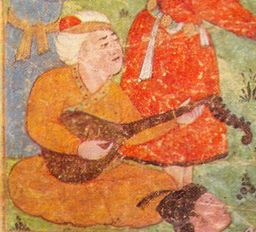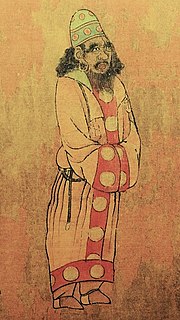 W
WAdhar Valash was an Iranian prince from the House of Karen, who ruled Tabaristan and Gurgan under the authority of the last Sasanian emperor Yazdegerd III.
 W
WSaint Anastasius of Persia, was originally a Zoroastrian soldier in the Sasanian army. He later became a convert to Christianity and was martyred in 628.
 W
WAzad Peroz, known in Arabic sources as Azad Firuz, was an Iranian nobleman who served as the governor of the Sasanian province of Mazun during the reign of king (shah) Khosrow II. He was the son of a certain Gushnasp, and was given the nickname of muka'bir by the Arabs, because he cut the hands and feet of other people.
 W
WBarbad or Barbad-ī Marvazi was a Persian musician of the Sasanian era, who lived during the rule of Khosrau II, 590 to 628.
 W
WGil Gavbara, also known as Gavbarih, was king and founder of the Dabuyid dynasty in 642, ruling until his death in 660.
 W
WHormuzan was an Iranian aristocrat who served as the governor of Khuzestan, and was one of the Sasanian military officers at the Battle of al-Qādisiyyah. He was later taken prisoner by the Muslims after the fall of Shushtar in 642. Two years later, he was accused of the assassination of the Rashidun caliph Umar, and was killed by 'Ubaid-Allah, the deceased caliph's son.
 W
WJavanshir, was the prince of Caucasian Albania from 637 to 680, hailing from the region of Gardman. His life and deeds were the subject of legends that were recorded in Armenian medieval texts. He was from the Parthian Mihranid family, an offshoot of the House of Mihran, one of the seven Parthian clans of the Sasanian Empire.
 W
WMihr Hormozd was an Iranian nobleman from the House of Suren. He was the son of Mardanshah, the padgospan of Nemroz, who was later executed by the orders of the Sasanian king Khosrau II. In 628, Khosrau was overthrown by his son Kavadh II, and was taken to prison, where he was shortly executed by Mihr Hormozd who sought to avenge his father's death. However, after the execution, Kavadh had Mihr Hormizd killed.
 W
WNarsieh was a Persian general who fled to the Tang dynasty with his father Peroz III, son of Yazdegerd III, the last Sassanid emperor of Persia, after the Muslim conquest of Persia.
 W
WPeroz III was son of Yazdegerd III, the last Sasanian King of Kings of Iran. After the death of his father, who legend says was killed by a miller at the instigation of the governor of Marw, he retreated to territory under the control of Tang China. He served as a Tang general and the head of the Governorate of Iran, an exiled extension of the Sassanid court. Most of what is known of Peroz III is written in the Old Book of Tang and the New Book of Tang.
 W
WRabban Mar Hormizd was a monk who lived in the seventh century in modern northern Iraq. Rabban is the Syriac term for monk. "Rabban" is also the Aramaic word for "teacher". He founded the Rabban Hormizd Monastery in Alqosh, named after him, which has served in the past as the patriarchate of the Church of the East.
 W
WRostam Farrokhzād was an Iranian dynast from the Ispahbudhan family, who served as the spahbed of the northwestern quarter (kust) of Adurbadagan during the reign of Boran and Yazdegerd III. Rostam is remembered as a historical figure, a character in the Persian epic poem Shahnameh, and as a touchstone of most Iranian nationalists.
 W
WSalman the Persian or Salman al-Farsi, born Roozbeh, was a companion of the Islamic prophet Muhammad and the first Persian who converted to Islam. During some of his later meetings with the other Sahabah, he was referred to by the kunya Abu Abdullah. He is credited with the suggestion of digging a trench around Medina, a Sasanian military technique, when it was attacked by Mecca in the Battle of the Trench. He was raised as a Zoroastrian, then attracted to Christianity, and then converted to Islam after meeting Prophet Muhammad in the city of Yathrib, which later became Medina. According to some traditions, he was appointed as the governor of Al-Mada'in in Iraq. According to popular tradition, Muhammad considered Salman as part of his household. He was a renowned follower of Ali ibn Abi Talib after the death of Muhammad.
 W
WShahrbaraz, was king (shah) of the Sasanian Empire from 27 April 630 to 9 June 630. He usurped the throne from Ardashir III, and was killed by Iranian nobles after forty days. Before usurping the Sasanian throne he was a general (spahbed) under Khosrow II (590–628). He is furthermore noted for his important role during the climactic Byzantine–Sasanian War of 602–628, and the events that followed afterwards.
 W
WShirin was a wife of the Sassanid Persian Shahanshah, Khosrow Parviz. In the revolution after the death of Khosrow's father Hormizd IV, the General Bahram Chobin took power over the Persian empire. Shirin fled with Khosrow to Syria, where they lived under the protection of Byzantine emperor Maurice. In 591, Khosrow returned to Persia to take control of the empire and Shirin was made queen. She used her new influence to support the Christian minority in Iran, but the political situation demanded that she do so discreetly. Initially she belonged to the Church of the East, the so-called Nestorians, but later she joined the miaphysite church of Antioch, now known as the Syriac Orthodox Church. After conquering Jerusalem in 614, amidst the Byzantine–Sasanian War of 602–628, the Persians captured the True Cross of Jesus and brought it to their capital Ctesiphon, where Shirin took the cross in her palace.
 W
WVaraz Trdat - was the Mihranid king of Caucasian Albania from 670 to 705. He was kept as prisoner in Constantinople from 694 until 699, in his absence his queen Sparama and regent prince Shero was in a quarrel. Shero was prisoned by Arabs when Trdat came back to throne. After his death, kingdom abolished and Mihranids stood as princes of Gardman.
 W
WVarkhuman, also Vargoman was an Ikhshid (King) of Sogdia, residing in the city of Samarkand in the 7th century CE. He succeeded King Shishpin. He is known from the murals of Afrasiyab in Samarkand, where is seen being visited by embassies from numerous countries, including China. There is also an inscription in the murals directly mentioning him. His name is also known from Chinese histories.